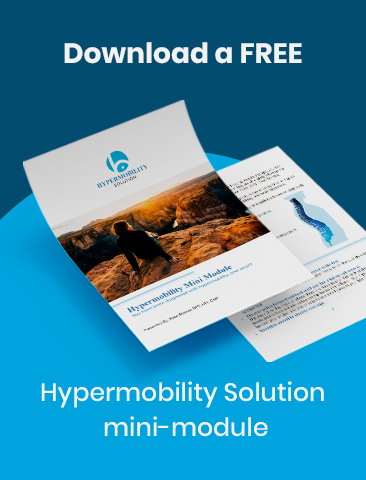May has a special place in my heart – it’s Hypermobility Awareness Month! A perfect time for understanding hypermobility and shedding light on a condition often shrouded in misconceptions and misinformation. Here’s what you need to know about hypermobility and how you can support awareness.

What Exactly is Hypermobility?
Hypermobility is a predominantly inherited connective tissue disorder characterized by joint laxity. Its exact cause remains unclear, but it’s thought to be linked to systemic collagen abnormalities. This can lead to issues not only in the joints but also in cardiac tissues, the gastrointestinal system, and manifest as skin laxity, among others.
Also, Hypermobility comes with many comorbidities that can make life hard to manage. You can check the most common ones here.
Why We Need Hypermobility Awareness Month
Despite its prevalence, misconceptions about hypermobility abound. Many still believe that it:
- Isn’t a real condition.
- Isn’t painful.
- Is merely about being “bendy.”
- Is a mental issue rather than a physical one.
Hypermobility Awareness Month aims to challenge and correct these misbeliefs, ensuring people truly understand the condition.

Topics Every Hypermobile Individual Should Be Aware Of
Diagnosing Hypermobility
Diagnosing this condition can be a maze. Traditional methods like the Beighton score can offer some insights but have their limitations. It’s essential to consider other symptoms and seek a comprehensive medical opinion if you suspect you have the syndrome.
Mechanics & Daily Habits: Their Impact on Hypermobility
How you walk, sleep, exercise, and even sit can profoundly affect hypermobility symptoms. Here’s a brief guide:
- Posture: Good posture eases muscle strain and joint force, making daily activities less taxing.
- Alignment: Ensure that your spine, pelvis, shoulders, knees, and ankles are correctly aligned.
- Standing & Sitting Habits: Be mindful of your stance. Maintain weight evenly on both feet, ensure shoulders are over hips, and ears over shoulders.
- Sleeping Patterns: Avoid sleeping on your stomach as it can exacerbate neck issues. Opt for sleeping on your back or side while maintaining alignment.
- General Movement Tips: Balance your activities, avoid crossing legs, and steer clear of prolonged rotated positions.
Avoid sleeping on your stomach. While often a favorite position, this is a quick way to aggravate or start a neck problem.

Engaging with Hypermobility Awareness Month
Awareness is the first step towards change. Here are ways to make a difference.
- Share your Hypermobility story.
- Help debunk Hypermobility myths.
- Share Hypermobility life hacks.
- Share a Hypermobility related statistic.
- Engage with the Hypermobile community.
- Talk to people about your condition.
- Wear Hypermobility related merchandise.
- Create Hypermobility Awareness Month events.
- Enroll in any of the Ehlers-Danlos Society challenges.
You can start by sharing this blog post with everyone you know!
This Hypermobility Awareness Month, let’s get together as a community to open the gates of information to everyone.
Awareness about our connective tissues is something we have been neglecting for ages, and now it’s time to start shifting attention to how they are a crucial part of our health.
If you are looking for Hypermobility resources, feel free to check out my blog.
Looking to manage your Hypermobility symptoms?
Check out the Hypermobility Solution, the Hypermobile Neck Solution, and Hypermobility 101.

About Kate

Kate Skinner is a Doctor in Physical Therapy, co-founder of Great Divide Physical Therapy, and creator of Hypermobility Solution.
Recent Posts


